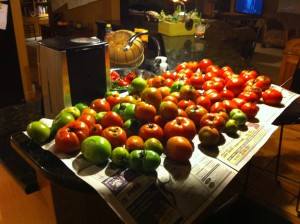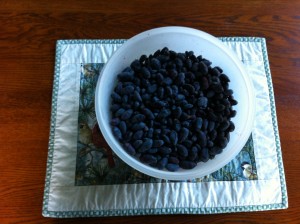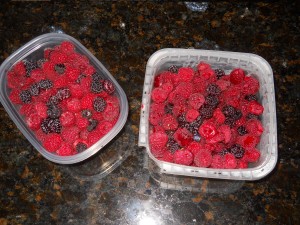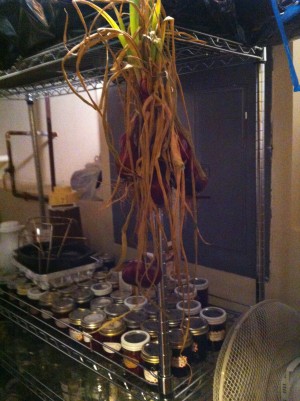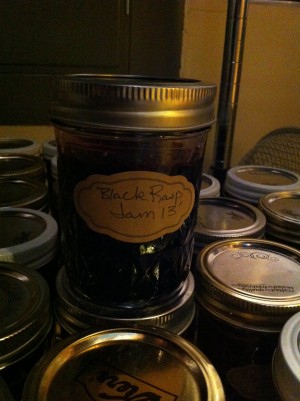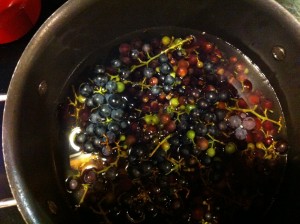Rene’ and I have lived in the country for nearly thirty years. We’re city kids by heritage, folks who never raised a carrot or a pea or a potato until we wandered out to Fredenberg Township in 1984 on the off-chance that the Sears house described in a “for sale by owner” ad in the local paper might be big enough to hold our growing family. We were living in a neat and trim little bungalow on St. Marie Street a stone’s throw from UMD and had been looking for a bigger place for the better part of a year. We toured dozens of homes, made an offer on one or two, but providence must have been on our side because the offers we made, offers which would have kept us in town, were all rejected. That first visit to the Drew place (a country home retains the name of the last family who lived there) I brought Matt, our eldest son, who was four years old at the time, along. Gerry and Ruby Drew gave us a tour of the house, old dairy barn, garage, chicken coop, and the seven acres that made up the farm. A neighbor, Charlie Davidson, happened by while Matt and I were there. Charlie stopped in to deliver a load of mulch for the farm’s impressive raspberry plot. I think it was the black water of the river flowing by the house, more than the home’s history of having arrived in crates from Sears and Roebuck, or the well-worn interior of the house itself, or the vegetable garden that led me to conclude This is the place. The next day, I dragged my very pregnant wife out to see the farm and within a week, our offer to buy the place was accepted.
It took a while to get the details of hobby farming down. Failed attempts to raise strawberries. Dusting potatoes for potato bugs. Figuring out how just how many beans and peas we really wanted to eat in a year. Deciding that blanched corn-on-the-cob in February doesn’t hold up all that well; that corn-on-the-cob is best enjoyed fresh, right out of the garden and that the only way to eat it in February is after removing it from the cob and smothering it in butter. These are things we learned as we went along. But, unlike most of our neighbors, whose attempts to fence out marauding deer generally met with disaster, our vegetable garden remained, until very recently, untouched by antlered foe. Our black Lab mix, Daisey (and before her, a litany of other Labradors) have kept hoofed invaders at bay. But age has crept into Daisey’s bones and she no longer has the gumption to challenge deer. More about that later
After we bought the Drew place and moved in, I approached Gerry about buying a 15 acre pasture he owned down river from the Sears house. We came to an understanding and the land was added to our hobby farm. For the fifteen years we had horses, the pasture provided hay to feed the animals through winter. But every time something would go wrong with the aging Sears house or whenever Rene’ sat in repose looking across Knudsen Creek at the vacant hay field, I knew we were getting closer and closer to building a home. It happened. We sold the Drew place, which became the Munger place as soon as we left, and moved down river. The weird thing is that, even before the first spade of sandy loam was turned for the foundation of our new house, we tilled and planted a vegetable garden at the new site. And it didn’t take long for the deer to discover the plot. So, when we moved in, I built a fence around the vegetable garden, which, along with our Labradors’ patrols, seemed to do the trick. Then, two years ago, crows discovered our corn as the ears ripened in the July heat. The birds made short work of the golden kernels and, for good measure, pulled up all the newly germinated seeds of the other garden plants, eating the seeds and leaving leafy evidence of their foul deed behind. Jack, our youngest son, tried to reproach the flying pests with pellets and BBs to little effect. Netting tossed over critical plants didn’t seem to help.
This summer, the corn never germinated and, cognizant of the crows, I didn’t replant. Instead, I filled the vacant rows with extra tomato and potato plants. True to the season, though a full two weeks’ behind schedule, the first crop we harvested this year was the Russian berries, a sweet, full flavored berry that grows on bushes. Next, the red and black raspberries, normally harvested in early June, but full on the cane this summer until mid-July, turned glorious red and deep black under the sweltering sun. I picked raspberries for weeks.
In August, Rene’ took in the potatoes and carrots. Not an over abundant cornucopia of root crops but enough for some good meals. She cleaned the potatoes and stored them in bins and blanched and froze the carrots. I should have suspected something was amiss when she brought in the carrots. There were no tops to the tubers. The deer had hopped the four-foot-high fence and nipped the tender green caps off every single plant. But the carrots themselves were unharmed and made for an impressive display on the counter once they were all sealed in plastic and ready for the freezer. My ever diligent wife then took the berries we’d harvested, along with blueberries she and I picked at a commercial farm, and canned over 60 pints of blueberry, Russian berry, black raspberry, and red raspberry jam. She also hung onions from the garden in our basement for use in making her famous spaghetti sauce and salsa.
I was gone on a Boy Scout outing to Canada when Rene’ did all this work. By the time Jack and I came back from Ontario, all that remained in the garden were some football-sized orange and green zuccini, assorted peppers, a few isolated tomatoes, and the pride of my green thumb: clusters of ripening grapes. That’s right, grapes. I know, I know. We’re a bit far north to get serious about becoming vintners. Where it normally takes three years to get a grape vine to produce fruit, up here in the great white north, it’s taken ten years to see success. That’s right: the grapes we grew this year began as shoots a full decade ago. When I returned home last weekend from another out-of-town trip, the first thing I did was to amble over to the vegetable garden and check out my grapes. I bit into the darkest blue grape I could find.
Still not quite ripe.
My plan was to let the grapes ripen on the vine and then harvest bunches of beautiful dark blue fruit for use in jelly and maybe, just maybe, a bottle or two of wine. Rene’s been into wine making for a few years but has always gone to the local wine crafting store and used kits to start her wine. It looked to this neophyte vintner that we’d have enough grapes for a few bottles of home brew and the two of us were giddy with excitement to try and ferment our own grapes into soft, delicate red wine.
You know what? Turns out that deer really like grapes. Those bastards are very good at nibbling clutches of purple grapes right off the vine. While Daisey nursed her hips, and the sun ripened the clutches of blue into deep velvet, those damned cloven hoofed devils were planning and scheming to rob us. Yesterday when I came home from work intent on harvesting (excuse the cliche’) the fruits of my labor, I found only a quarter of the grapes remained on the vine. Nearly every big, lush, beautiful bunch had been eaten. I nearly cried. I picked what I could, a paltry, dismal harvest, and lugged the basket of grapes and some random, ripening peppers back to house.
I need to raise the height of the fence so this never happens again.
The best laid plans…
Peace.
Mark

